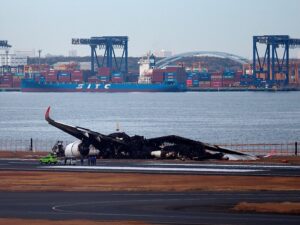
Japan Airlines Flight 516 wreckage at Haneda Airport
Photo Credit: Makochan12.9 (http://tinyurl.com/mry28x6h)
Learning from the Japan Airlines Flight 516 Crash
The recent crash involving Japan Airlines Flight 516 at Haneda Airport serves as a lesson not all agrees in the past, that one should leave all belongings behind during an emergency evacuation.
On that fateful day of January 2, 2024, a JAL Airbus A350 collided with another Japan Coast Guard Dash 8 plane during its landing approach, resulting in a potentially catastrophic situation.
However, the outcome was far from disastrous due to the remarkable survival of all 379 person on board.
A major factor in this positive outcome was the passengers’ adherence to instructions to leave their baggage behind during the evacuation. This decision prevented delays that could have resulted in significant fatalities.
Aboard the Dash 8, only the captain survived out of the six crew members. The crash occurred as the Dash 8 pilot mistakenly taxied onto an active runway, when the Airbus A350 was landing.
Compounding the situation, the stop bar light intended to warn against runway entry was out of service at the time.
The JAL pilots later reported that they have no visual contact with the smaller aircraft. As such, they did not discuss aborting the approach. JAL also did not clarify why their pilots failed to see the coast guard aircraft on the runway.
Despite the fiery collision, all occupants of JAL Flight 516 successfully evacuated within 20 minutes using emergency slides. This quick and effective evacuation was attributed to passengers promptly following instructions and leaving their belongings behind.
Comparing this successful evacuation to the Sukhoi Superjet 100 which caught fire in a hard emergency landing in Moscow in 2019. There, 41 of the 71 people aboard failed to get out in time before the plane was engulfed in flames.
Those who evacuated successfully were seen carrying their hand luggage as they slid down the emergency slides.
Did the A350 fuselage made from about 54% carbon composite materials contribute to the success of the evacuation?
Well, unlike aluminum, carbon does burn, but the resin-impregnated composite does so slowly, giving the passengers enough time to escape.
Further, the aircraft interiors are also designed to prevent flames spreading for as long as possible to allow for safe evacuation.
Could the crash be avoided?
In 2018, Airbus announced efforts to install a Surface-Alert system designed to warn pilots about potential runway collisions.
Unfortunately, as of the crash, the system remained under development, emphasizing the need for expedited implementation of such safety features.
The lesson learnt from the Japan Airlines Flight 516 crash is clear: during emergency evacuations, please leave all your personal belongings behind!
View a you tube video Japan Airlines plane on fire at Tokyo’s Haneda Airport